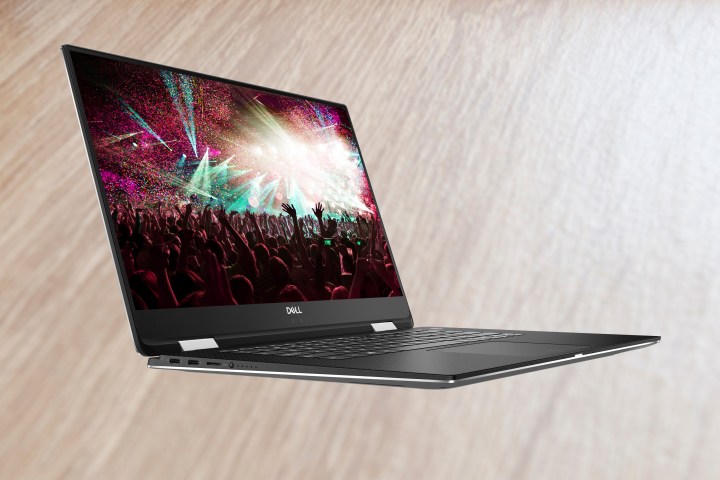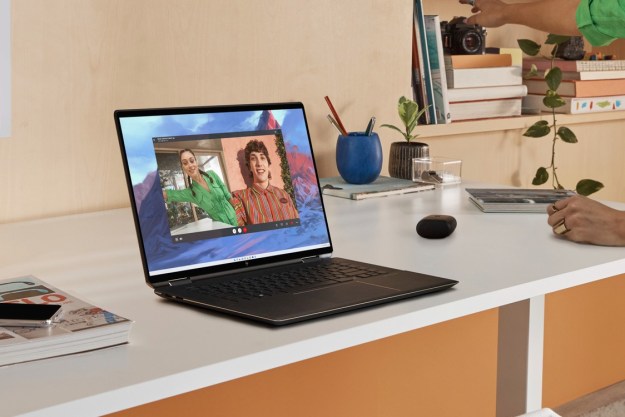
We pit the HP Spectre x360 15 vs Dell XPS 15 2-in-1, taking a look at two major players in the large 2-in-1 space to see which does the best job of matching a 2-in-1’s flexibility with the advantages of a large, high-resolution display.
Specs
Design
HP’s new Spectre x360 15 has a tried-and-true design that we thoroughly enjoyed in the Spectre x360 15 released in early 2017. The machine boasts a similar design to one of our favorite convertible 2-in-1s, the HP Spectre x360 13, only made larger and packing in a 15.6-inch display. The smaller version received its own refresh late in 2017, chiseling a reduced chassis with sharper and more angular lines, and its larger sibling now follows suit. It’s a great-looking machine with its Dark Ash Silver and Copper Luxe accent color scheme, and its also very well built with its solid all-aluminum chassis.

Dell’s XPS 15 2-in-1, while brand-new, also take design cues from its smaller sibling, the excellent XPS 13 2-in-1. It utilizes a similar silver aluminum chassis and black carbon fiber keyboard deck, which gives it both a conservative yet attractive aesthetic and a very robust build quality. Dell kicks things up a notch, however, by using a rather exotic Gore Thermal Insulation material — the kind you’ll find in running jackets — that promises to direct heat out of the chassis and help keep the processor running at full speed.
It’s hard to argue against the HP’s elegant and modern design, but Dell is packing some material advantages (no pun intended) into its XPS 15 2-in-1 that demonstrate a real attention to detail. We give the Dell the design win.
Winner: Dell XPS 15 2-in-1
Performance
One of the more intriguing developments for early 2018 is the introduction of Intel’s new quad-core Kaby Lake-G CPUs that are mated with AMD Radeon RX M GPUs. There are two versions of this chipset, one that utilizes the Radeon RX Vega M GL that competes with Nvidia’s GeForce GTX 1050, and one that builds in the Radeon RX M GH that competes with Nvidia’s GeForce GTX 1060 with Max Q.
Both machines should offer similar high-end performance but without knowing heat generation, battery life, etc it’s hard to say who will win
HP is offering the Spectre x360 15 in two versions. One utilizes the Kaby Lake-G CPU, specifically the i7-8705G, that packs in a Radeon Vega M GL. The other is a holdover from a late 2017 refresh that mates an eighth-generation quad-core Intel i7-8850U and an entry-level discrete Nvidia GeForce MX150.
Dell, on the other hand, skips the lowest performance option entirely. Instead, it’s offering the XPS 15 2-1 with either a Core i5-8305G or Core i7-8705G, both using the Radeon Vega M GL GPU.
Ultimately, both machines should offer similar performance at the high end, while the XPS 15 2-in-1 will offer more performance in its lower cost option. Without more to go on regarding how the Intel/AMD mashup will perform and what costs there might be in terms of heat generation, battery life, and other considerations, it’s difficult to say which machine will win this battle.
Winner: Tie
Keyboard, Mouse, and Pen
HP revised its excellent keyboard from the previous model, squeezing in a numeric keypad and getting rid of the row of home buttons along the right-hand side. We like the keyboard feel of the previous model, lauding its precise feel and copious amounts of travel, but we’ll have to reserve judgment until we have a chance to check out the updated version.

HP also moved the touchpad slightly to the left to make it fit more comfortably underneath the keyboard, and we hope that it uses the Microsoft Precision Touchpad protocol rather than the Synaptics driver that we found somewhat less precise and responsive. Finally, the Spectre x360 15 can use either of HP’s active pens, both of which offer 1,024 levels of pressure sensitivity, and the upgraded version, that offers a rechargeable battery and laser-pointer-like gyroscope.
With its cool-sounding mag-lev keyboard and more precise pen, we have to give Dell the nod for sheer innovation.
Dell started from scratch with the Dell XPS 15 2-in-1’s input options. First, it created a completely new and very innovative-sounding Mag-Lev (magnetic levitation) keyboard offering 0.7mm of travel. That sounds low (the Spectre x360 15 offers 1.5mm of travel), but we’ve had a chance to try it, and were fairly impressed — though we’d like to use it for more than a few minutes before making a verdict.
The Dell offers a Microsoft Precision touchpad with a glass surface and integrated button, and there’s a new Dell Active Pen that offers a full 4,096 levels of pressure sensitivity and tilt support. That makes it the equal of the excellent Microsoft Surface Pro, and Surface Book 2’s Surface Pen.
Both machines enable Windows 10 Hello password-less login support via fingerprint reader, but the Spectre x360 15 also offers an infrared camera for facial recognition. In spite of this additional security option, we have to give Dell the nod for sheer innovation with its cool-sounding mag-lev keyboard, and also its more precise pen.
Winner: Dell XPS 15 2-in-1
Connectivity
The HP Spectre x360 15 has a solid collection of ports to meet both legacy and future connectivity needs. A full-size HDMI port sits next to two USB-C ports on the right-hand side. On the Nvidia version, one of them provides Thunderbolt 3 support, while on the AMD version both are

The Dell XPS 15 2-in-1 is looking entirely to the future with its selection of connectivity options. There are four USB-C connections on hand, two of which are USB-C 3.1, and two of which support
Ultimately, we appreciate HP’s inclusion of old-school connectivity with the USB-A and HDMI ports. That just means two fewer dongles. Both machines offer USB-C and
Winner: HP Spectre x360 15
Display
HP’s Spectre x360 15 has always offered only one display option, a very nice 15.6-inch 4K UHD (3,840 x 2,160 or 282 PPI) resolution panel that offers decent color support and good enough contrast. Given the convertible 2-in-1’s ability to flip over the display to media view mode, it makes for a great
On paper, Dell is promising a superior viewing experience.
Dell will be offering two display options for the XPS 15 2-in-1, 15.6-inch Full HD (1,920 x 1,080 or 141 PPI) and
We’ll have to get the machines in our offices and get busy with our colorimeter to see which display is better. However, on paper, Dell is promising a superior viewing experience; based on the excellent
Winner: Dell XPS 15 2-in-1
Portability and Battery Life
While HP shaved off a few fractions of a millimeter from the HP Spectre x360 15’s bezels and therefore packed everything into a slightly smaller chassis, it increased the machine’s thickness 0.06 inches (to 0.76 inches). It also upped the weight from 4.4 pounds to 4.62 pounds for the Nvidia version and 4.72 pounds for the AMD version.
That concession to slightly less comfortable portability allowed the company to squeeze in a larger battery, 84 watt-hours versus the previous model’s 79.2 watt-hours. HP promises 13.5 hours of battery life from the Nvidia version, and 12 hours from the more powerful AMD version.

Dell focused more on making the “smallest, thinnest 2-in-1 in its class,” and the XPS 15 2-in-1 certainly qualifies. It’s significantly thinner than the HP at 0.63 inches and it’s much lighter at 4.3 pounds. The company says battery life will reach 15 hours with the machine’s 75 watt-hour battery, but we imagine this refers to the Full HD configuration. The
Which machine wins this round depends entirely on whether you want longer battery life with a
Winner: Dell XPS 15 2-in-1
Availability and Price
The HP Spectre x360 15 will start at $1,370 for the Nvidia version with 8GB of RAM and a 256GB PCIe solid-state drive (SSD), while the same model with 16GB of

We don’t yet have much pricing information for the Dell XPS 15 2-in-1. All we know at this point is that pricing will start at $1,299, which is likely the low-end configuration with a Full HD display. Given the premium nature of the XPS 13 2-in-1, we imagine that pricing on the larger model will ramp up quickly.
The Spectre x360 15 should be available in March 2018, while Dell has only indicated a more general Spring 2018 availability date. We have to give the nod the HP here for likely being the more affordable solution, but that’s based only on the Spectre x360 15’s earlier pricing models.
Winner: HP Spectre x360 15
The Dell just seems more like the future
Both HP and Dell are making good use of Intel’s new partnership with AMD, putting out attractive and likely well-built convertible 2-in-1s with graphics performance equalling Nvidia’s GTX 1050. That means that both will perform well in high-end productivity and creativity tasks like video editing, while also running modern games at 1080p and decent graphics quality.
The XPS 15 2-in-1 is likely to be a bit more expensive, it’s thinner and lighter, and it’s probably going to have a nicer display. The Spectre x360 15, on the other hand, should have better battery life with the
In the end, though, we do love companies that push the technology envelope. Dell is doing just that by incorporating a mag-lev keyboard and Gore Thermal Insulation, and for that reason, we’re going to give it the win in this shootout.
Editors' Recommendations
- Dell XPS vs. Dell Latitude: here’s how to decide
- HP’s new Envy x360 14 looks like a killer value for what you get
- Asus ZenBook S 13 Flip vs. HP Envy x360 13: it comes down to price
- The redesigned new Dell XPS 13 2-in-1 officially launches on August 25
- Dell’s new XPS 13 2-in-1 rivals the Surface Pro, minus the headphone jack


